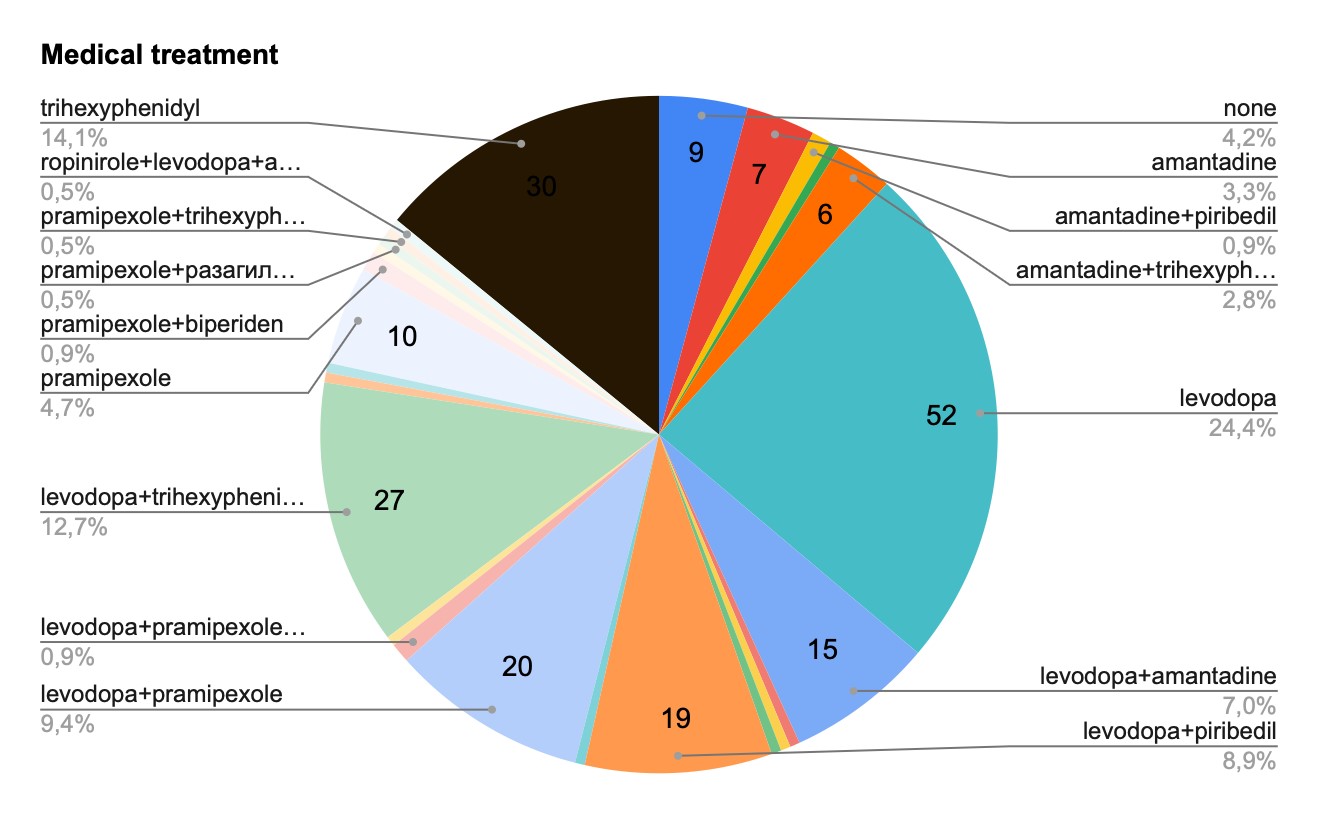Category: Epidemiology
Objective: This study compares Parkinson’s disease (PD) and parkinsonian syndromes (PS) in patients at a Kyrgyzstan university hospital. It analyzes data from 2016-2017 [1] and 2022-2023, focusing on demographics, disease presentation, diagnostics, and treatments. This provides insights into the prevalence and features of PD and PS in the region, building on a prior study in Kyrgyzstan.
Background: White
Method: Medical records were reviewed for patients diagnosed with PD or PS from January 2022 to December 2023. A total of 214 records were analyzed, with data extraction focusing on demographic information, age of onset, disease severity using the Hoehn and Yahr scale, clinical features, diagnostic procedures, and treatment modalities.
Results: Analysis of 214 patient records revealed a female predominance, with 119 patients (55.6%) as female. PD was diagnosed in 186 cases (86.9%), while PS were diagnosed in 28 cases (13.0%). Among the PS cases, vascular parkinsonism was identifiedwith with 24 cases (85.7%), followed by one case of postencephalitic parkinsonism (3.6%) and 3 cases of multiple system atrophy (10.7%). The age range of patients spanned from 38 to 81 years old, with an average age of 59.5 years. Only in 6 patients with PD (3.2%) the Hoehn and Yahr scale wasn’t applied. Rigid form was diagnosed in 45 patients (21.0%), tremor form in 50 patients (23.4%), and mixed form in 91 patients (42.5%). MRI was conducted in 153 cases (71.5%). Surgical interventions were performed on three patients (1.4%), resulting in positive outcomes. In terms of therapy [figure 1], 52 patients (24.4%) were on monotherapy with levodopa, 30 patients (14.1%) were on trihexyphenidyl, and 27 patients (12.7%) were on combined therapy using levodopa and trihexyphenidyl. Nine patients (4.2%) were without therapy.
Conclusion: Comparing the results from 2016-2017 to 2022-2023 reveals notable changes in several key areas. In the earlier, there was a relatively balanced gender distribution among patients, with a prevalence of PS. However, in the later period, there was a distinct shift towards a female predominance and a higher PD cases. MRI utilization increased notably from 43.3% to 71.5%, and diagnostic practices improved, with 96.8% of patients having the Hoehn and Yahr scale applied compared to 27.6% previously. This indicates a shift towards to better management and understanding of movement disorders in the later period.
Figure 1
References: 1 C. Shambetova. Prevalence of Parkinson’s disease and parkinsonism in Kyrgyzstan [abstract]. Mov Disord. 2019; 34 (suppl 2). https://www.mdsabstracts.org/abstract/prevalence-of-parkinsons-disease-and-parkinsonism-in-kyrgyzstan/
Accessed March 13, 2024.
To cite this abstract in AMA style:
S. Medetbekova, B. Nurbekova. Changes in Parkinson’s Disease and Parkinsonian Syndromes A Comparative Retrospective Study in Kyrgyzstan [abstract]. Mov Disord. 2024; 39 (suppl 1). https://www.mdsabstracts.org/abstract/changes-in-parkinsons-disease-and-parkinsonian-syndromes-a-comparative-retrospective-study-in-kyrgyzstan/. Accessed January 4, 2026.« Back to 2024 International Congress
MDS Abstracts - https://www.mdsabstracts.org/abstract/changes-in-parkinsons-disease-and-parkinsonian-syndromes-a-comparative-retrospective-study-in-kyrgyzstan/

